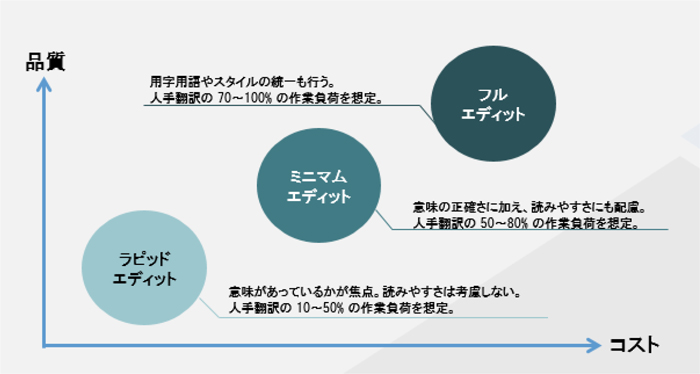Customer Requests

This customer, being a foreign company, had already implemented machine translation for European languages from English. However, when they tried to introduce machine translation using the same engine for Japanese-English translation, they had a bad experience where the quality was poor and it ended up costing them more time and money.
Therefore, we have proposed a machine translation engine suitable for Japanese-English translation and have also provided support for post-editing. As a result, we have successfully reduced translation costs and lead time from Japanese to English by "40%" compared to traditional human translation.
Human Science Solutions
At Human Science, we have provided the following consulting services to successfully introduce machine translation in Japanese-English translation.

We supported the introduction of machine translation in this project through the following steps.
①Proposal for a machine translation engine suitable for Japanese-English translation
The preferred languages and fields may vary depending on the machine translation engine. For example, even if the same document is translated, the quality can vary greatly depending on the machine translation engine used. Therefore, when introducing machine translation, it is extremely important to select a machine translation engine that is suitable for the target document and language. This time, ・We do not want to spend too much on operating costs for the machine translation engine ・There is no past translation data such as translation memory ・For support content, it is acceptable for the translation to be slightly unnatural as long as the meaning is accurately conveyed Based on the customer's request, we have proposed multiple candidates and suggested a machine translation engine suitable for Japanese-English translation. We conducted a quality verification and cost-effectiveness calculation with the proposed engine in advance, and after confirming the expected effects of introducing machine translation, we officially implemented it.
②Setting Quality Standards
In order to successfully implement machine translation, it is also important to establish quality standards in advance for the post-editing process, which is called "post-editing". By establishing quality standards in advance, it is possible to prevent excessive quality or excessive costs in the post-editing process. The following figure shows the correlation between the target quality standards and the three levels of correction in post-editing.
This time, we received a request from the client that "for support content, the quality of the translation can be slightly unnatural as long as the meaning is accurately conveyed," so we decided to perform post-editing at the "Rapid Edit" level, which has the least amount of machine translation corrections. In "Rapid Edit," we do not make corrections from the perspective of readability, so as long as the meaning is accurately conveyed, we will not make corrections even if there are slightly unnatural expressions or terms. We confirmed with the client that the results of post-editing conducted with this policy met the target quality, and we provided it as a sample for their confirmation.
③Post-edit Implementation
Post-editing was carried out by compiling a checklist of correction points at the "Rapid Edit" level, clarifying quality standards and correction points, and then implementing post-editing after sharing them with the responsible party.
Customer Feedback
“
Previously, we struggled with implementing Japanese-English machine translation, but now it runs smoothly and has been a great help.
After failing to use the same machine translation engine as European languages, we had given up on using machine translation for Japanese-English translation. However, we have discovered that by using an engine suitable for the target language, machine translation can be utilized even for Japanese-English translation.
1Support content can be translated from Japanese to English, reducing costs and lead time, and has also been recognized by our US headquarters.
In the future, we are considering introducing machine translation to other content such as internal documents and instruction manuals, in addition to support content.
”
From Human Science representative

This is a case where we supported the introduction of machine translation in Japanese-English translation. By selecting the optimal engine and conducting thorough quality verification and setting quality standards in advance, we were able to achieve cost reduction and lead time reduction even in Japanese-English translation. We often receive inquiries from those who have participated in our seminars and conferences: ・"Is it possible to introduce machine translation even in Japanese to English translation?" ・"Are there any cases where machine translation has been introduced in Japanese-English translation?" However, even in Japanese-English translation, it is fully possible to use machine translation to achieve cost reduction and shorten translation period. In the future, we are considering introducing machine translation in internal documents and instruction manuals, so we would like to continue working together to design processes tailored to each target document.





